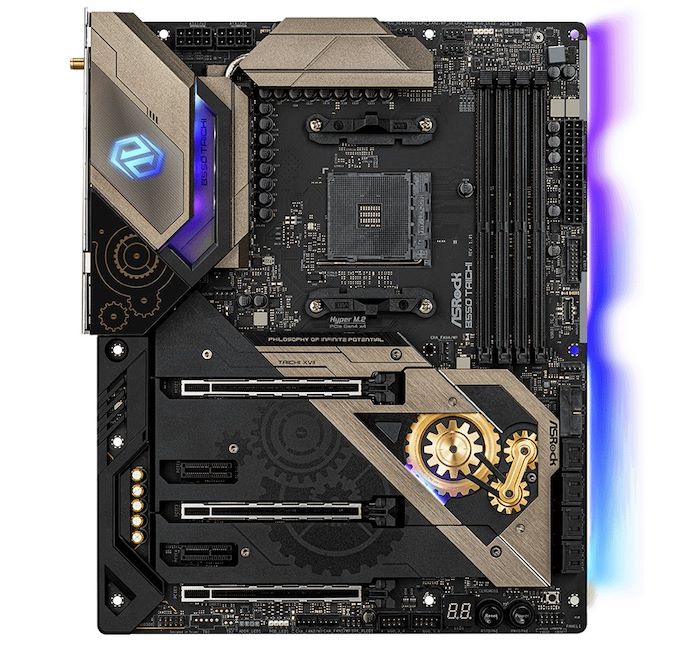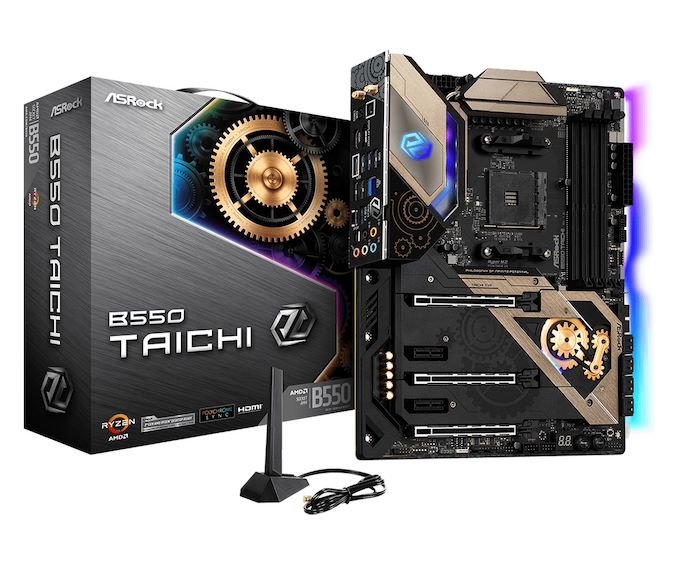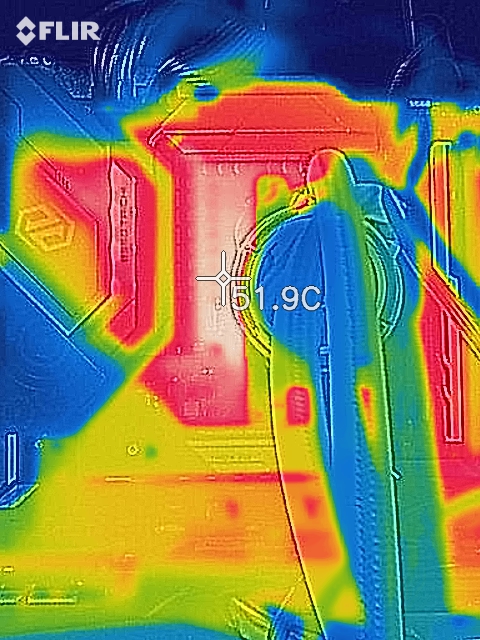ASRock B550 Taichi Review: The $300 B550 Motherboard with Chutzpah
by Gavin Bonshor on August 21, 2020 3:30 PM EST- Posted in
- Motherboards
- AMD
- ASRock
- Taichi
- AM4
- Ryzen 3000
- Ryzen 3700X
- Ryzen 4000
- B550
- B550 Taichi
_678x452.jpg)
Outside of its Aqua series of motherboards, which come with exquisitely crafted monoblocks, ASRock's Taichi brand has been a critical part of the company's offerings in the land of premium motherboards. The ASRock B550 Taichi sits at the top of its product stack and features an impressive quality feature set. Some of the most notable features include a large 16-phase power delivery, eight SATA ports, dual M.2 slots, an Intel 2.5 GbE Ethernet controller, and an Intel Wi-Fi 6 interface. At $300 it comes equal in price with the X570 version, which leaves questions on the table as to which one is actually worth the money.
When AMD first released the B550 chipset, a lot of fanfare was made about the high launch price of some models. For what has been usually considered a 'budget' chipset, some of the more premium B550 models cost more than some of the X570 models, which featured full support for PCIe 4.0 to add-in cards and the chipset. The B550 chipset has less PCIe 4.0 support than X570, with only the top full-length PCIe slot and one PCIe M.2 slot operating at PCIe 4.0, while the rest of the slots and chipset operate at PCIe 3.0. The trade-off is downstream bandwidth from the chipset as well as power, because the X570 requires a fan to keep that PCIe 4.0 chipset cool. Ultimately X570 requires 'more' to be fully enabled than B550, so it comes as a bit of surprise when the B550 and X570 models sit on equal pricing.
The ASRock B550 Taichi
Even with what has been said above, the ASRock B550 Taichi has all the hallmarks of a premium AM4 model with a solid array of controllers, ports, and power delivery.
Armed with its unique Taichi inspired design, the ASRock B550 Taichi follows a bronze and black color scheme with three customizable RGB LED zones. ASRock has installed the B550 Taichi with a large sixteen phase power delivery, which performs very well in our thermal testing. Unique to the ASRock range, the B550 Taichi is the only board where the top two PCIe slots support a PCIe 4.0 x8/x8 configuration - out of all other B550 boards, only two others have this feature.
Another solid benefit of the Taichi is that it includes a BIOS Flashback controller which allows users to update the firmware without a CPU installed. This is useful for when AMD launches Ryzen 4000 and a firmware update will be required to use the new Zen 3 processors. Some of the board's other core features include 2.5 GbE networking, Wi-Fi 6, and a premium audio codec with an assisting amplifier designed to bolster the quality of the front panel audio header.
After running our benchmarking suite, the ASRock B550 proved a consistent and solid performer in our testing. It displayed competitive performance in our system tests with strong power consumption figures in all three of our power tests, with a decent non-UEFI POST time of 20.6 seconds at default settings. In our CPU and gaming tests, the B550 Taichi performed competitively against other AM4 boards tested with our testbed Ryzen 7 3700X processor.
Our overclocking testing proved resourceful with a maximum stable overclock of 4.3 GHz with our Ryzen 7 3700X processor. Overall VDroop control was consistent throughout our testing, as was the performance in our POV-Ray benchmark testing. We saw equally impressive performance in our VRM thermal testing with the Taichi beating some of the more advanced and much more expensive X570 models. This is due to a more efficient power delivery design, as well as a solid pair of heatsinks which are interconnected via a single heat pipe for better heat dissipation. This is ultimately the reason why, despite being B550, this Taichi costs the same as the X570: better thermals and better power delivery.
The ASRock B550 Taichi as it stands is one of the most expensive B550 models with an MSRP of $300. This puts it up against ASRock's own X570 Taichi which currently costs $300 at Newegg. This puts the B550 Taichi in an awkward position in terms of value, with the X570 offering more raw features. However the B550 Taichi offers an alternative is the slightly larger power delivery (16-phase versus 14-phase), and an Intel 2.5 GbE Ethernet controller whereas the X570 Taichi is equipped with a standard Gigabit port.
Read on for our extended analysis and comparison tests.













61 Comments
View All Comments
dromoxen - Tuesday, August 25, 2020 - link
How do you connect your endpoints directly ? I would like 2.5gb for my next purch but lack of cheapish switches is a stumbling block ... 2500K needs retiring ..Or do I wait for ??Gigaplex - Wednesday, August 26, 2020 - link
My file server has 2 ethernet ports. I connect my desktop to my file server directly with an ethernet cable using the 2.5G port, and use the other ethernet port on the server to the rest of my network. The network connections are bridged on the server, so the desktop can see the rest of the network.Spunjji - Monday, August 24, 2020 - link
"Why 2.5GbE" - because some people keep their boards a long time, 1GbE is pretty slow for NAS storage needs and the kind of person spending $300 on a motherboard probably isn't going to use their ISP's router as their main switch?Most ISP routers aren't WiFi 6 yet either, so it's weird that you think *that* makes sense but not the 2.5GbE.
You've arbitrarily stated a "maximum price" for B550 that seems more appropriate for B520.
xrror - Monday, August 24, 2020 - link
Of all of the possible things to complain about, you pick having onboard 2.5GB NIC?I mean, it just seems a strange choice as a complaint?
TheinsanegamerN - Tuesday, August 25, 2020 - link
By that argument most motherboards shouldnt even have gigabit, but rather fast ethernet 100 Mbps.seamonkey79 - Sunday, August 23, 2020 - link
This is as stupid as paying $100 extra for a AIO with a screen on the waterblock.Greys - Wednesday, August 26, 2020 - link
CoolOxford Guy - Wednesday, August 26, 2020 - link
Yes, it’s cool to parlay a midrange chipset at a premium price point.Why? Who knows!
Everett F Sargent - Thursday, August 27, 2020 - link
"Yes, it’s cool to parlay a midrange chipset at a premium price point.Why? Who knows!"
Try this B550 board ...
https://www.gigabyte.com/Motherboard/B550-AORUS-MA...
If I wanted a 16-phase Voltage Regulator AND an MSRP below $300US ($280US) this looks like a pretty good option. I also am not into OC or gaming, so that I am fine with a very cheap graphics card running 8X and three M.2 PCIE 4.0 SSD's in RAID0 and a 3950X running stock. I'll also use ECC memory as this thing will be running all 32-threads 247 for weeks on end.
Plugin two (or one) additional PCIE 4.0 M.2's, the GPU is set to x8 instead of x16
So the question is, is there anything out there (AMD) that is available for a lower MSRP cost that has, at a minimum, a 16-phase Voltage Regulator? TIA
Oh and if you have a better solution for whatever reason(s) that would also be most useful.
I think the MB vendors know what they are doing, there appears to be no MSRP price overlap for comparable feature sets. Still trying to find an X570 that will do all that this MB can do at a lower MSRP price point.
I'm thinking of using this MB as a sort of test bed for my own numerical modelling codes (do I really need RAID 0 for I/O, RAM requirements and possibly some OC (depends on % improvement and temperatures, but gaining only a few percent seems to be rather pointless. which appears to be the current situation, I need more threads not a small % MHz improvement).
Oxford Guy - Tuesday, September 1, 2020 - link
I already said the VRM marketing pitch falls flat because these CPUs shouldn't even be overclocked.It's a gimmick and it flunks.